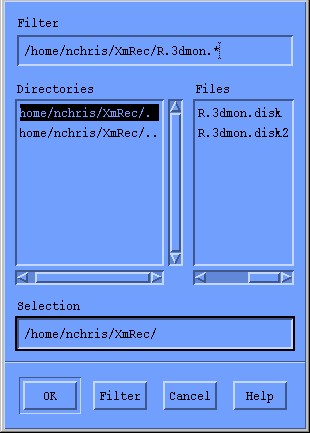
This chapter provides information about the 3dplay program.
With 3dplay, 3dmon recordings can be played back in the same style as the one in which they was originally displayed. When 3dplay is invoked with no argument, a file selection window such as the one shown in the following figure opens and shows a list of files that match the filter "R.3dmon.*" .
3dplay File Selection
When a valid 3dmon recording is provided as an input through the command line or through the file selection window, 3dplay displays its playback window immediately. An example of such a window is shown in Sample 3dplay Display.
Sample 3dplay Display
At the top of the window is a row of buttons, much like those of a video recorder. The buttons have the following functions:
If some other program is using the recording file at the time you attempt to erase it or if you are not authorized to delete the file, you are informed of this and are prevented from erasing the file.
In situations where a recording file spans over midnight so that the same time stamp exists more than once in the playback file, the seek proceeds from the current position in the playback file and wraps to the beginning if the time is not found. Because multiple data records may exist for any hour and minute combination, use the Play function to advance to the next minute before doing additional seeks on the same time, or seek for a time one minute earlier than the current playback time.
If you are playing back from a file while recording to the file is still in progress, the Seek function does not permit you to seek beyond the end time of the recording as it were when you first selected the file for playback.
The Seek button is not active while you are playing back.
Initially, playing back is attempted at approximately the same speed at which the data was originally recorded. When the recording was created by other programs than xmperf, and especially if the file is produced by merging several files, xmperf may have difficulty determining this speed. This may cause the start of the playback to be delayed. You can change the speed by using the Slower and Faster buttons.
While playing back, neither the Rewind nor the Seek buttons are active.
You can invoke the 3dplay from:
The syntax to invoke 3dplay from the command line is:
3dplay [RecordingFile ]
Where RecordingFile is the name of a recording file created by 3dmon. If a non-3dmon recording file is provided as input, 3dplay returns an error message and the recording file will not be played back.
3dplay can be executed from the "utilities" pulldown menu of the xmperf main window. The identification string to create the text shown on the utilities pulldown menu is "3-D Playback". When you select 3dplay from the "utilities" pulldown menu, 3dplay is invoked with no argument from a window as shown in the figure below.
xmperf 3dplay window
The 3dplay program can be invoked from the "File" pulldown menu of a 3dmon graph window. The File menu is shown in 3dmon File Menu . When you select Playback, 3dplay is invoked with no argument.